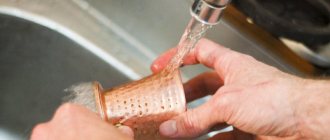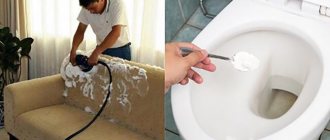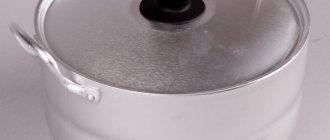The main “culprits” of blockages
First you need to figure out what causes a clogged pipe in the bathroom?
Most often, this problem arises as a result of human activity. The point is that a person cannot keep track of what ends up in the drain, because we are talking about long hair, animal hair, and pieces of rags. All this garbage is compactly packed in the sewer and forms a lump that blocks the passage of water. This is when water stagnation occurs, which you need to start fighting in time, without postponing this process for later.
It is better to prevent a clogged pipe than to look for a way out of the situation.
By the way, in a multi-storey building, the blockage can be local, that is, in one apartment, or general, if the central sewage system of the building is clogged. To determine the type of blockage, you should turn on the water in the kitchen and bathroom: if the problem is only in one place, the blockage is local and can be eliminated on your own.
When talking about the causes of blockages, one cannot fail to mention the following factors: fatty deposits in pipes, deterioration of the sewer system. In a word, there are several reasons, so the question of how to clear a blockage in the bathroom is extremely relevant.
Why is it necessary?
All people without exception know firsthand about such a plumbing device as a plunger. However, the design of the air plunger is not familiar to many, since it appeared relatively recently. Used for cleaning drains. Such a device has a more complex structure, but is a more effective way to solve the problems.
An air valve is a technical device that removes air from pipeline, sewer and heating systems. It is also used to run water inside the system to avoid the formation of a vacuum during the process of draining the system. Installation is carried out at the highest points of the systems. In ancient times, plungers were called small holes intended for air masses that were located in the arches of chimneys and ancient stoves.
It was only at the end of the nineteenth century that this name began to be used in relation to plumbing devices, which are more reminiscent of modern plungers, which are used when it is necessary to remove air masses from the system being used. By removing air bubbles, you can solve many problems that arise due to airiness in the system. Thus, the permeability of the working environment is significantly reduced, air pockets are formed and hydraulic shocks of varying power occur. With such devices, the risk of such situations occurring is greatly reduced. However, it is not only plungers that can solve the problems.
Using a plunger - traditional method
It is much more difficult to break through a clog with a plunger in a bathroom than in a sink, because draining the water complicates the process. The problem is that when the water starts to overflow, air gets into the opening, and a vacuum is needed to operate the plunger.
The plunger must be selected taking into account the size of the drain hole
How to clear a clog in the bathroom using a plunger? First, the above-mentioned hole for overflowing water is tightly closed with a stopper, and then the plunger, pre-lubricated with Vaseline, is pressed tightly against the drain and 10 sharp back-and-forth movements are made.
This is important to know: instead of a cork, you can use a second plunger to create the greatest tightness, but then you will need the help of another person.
If there is no result, you can try to push through the blockage not with air, but with water. To do this, you need to pour hot water into the bathroom (approximately to the height of half the rubber bowl) and immerse the plunger into the water at an angle. With the last pump, the plunger should be sharply pulled out of the water. If the blockage is not cleared the first time, the procedure is repeated several times.
Plumbing cable - a more serious method of cleaning
Everyone understands perfectly well that using a plunger can only clear minor blockages, so it is necessary to consider other methods of dealing with this nuisance.
The plumbing cable must be kept taut when clearing the blockage.
If the blockage is located far in the pipe or it is strongly compressed, they resort to cleaning using a cable. The essence of this method is that you need to hook the debris with a plumbing cable, pulling it out or pushing it into a wider pipeline.
This procedure proceeds as follows:
- the cable is inserted into the drain hole;
- one person pushes the cable, and the other rotates it;
- after passing through the clogged area, you need to make a couple of sharp jerks back and forth, then open the hot water tap and carefully pull out the cable to wash off the dirt that has formed in the sewer pipe.
It is worth paying attention: rotating the cable helps to better destroy the blockage.
Plumbing cable is sold at a hardware store, but you can make it yourself. To do this, you need to take a piece of a fairly flexible metal cable, bend it and fluff the tip a little. Thanks to this manipulation, the cable will move well along the bends of the pipe and will not rest against the knee.
This is important to know: for ease of grip, the cable should be wrapped in something rigid to form a kind of handle.
It is also necessary to mention the fact that a plumbing cable should absolutely not be used to clean plastic, chrome-plated pipes - then their inner surface can be damaged.
Nuances and tips for use
To successfully remove clogs in sewer pipes, the following points must be taken into account:
- It is first necessary to assess the severity and most likely causes of sewer obstruction. If large materials, garbage, food waste and similar objects entered the blockage before the blockage, then you can try to deal with the blockage yourself. If you have doubts, but there are no obvious reasons, then it is better to use the help of specialists so as not to cause even more harm.
- You need to understand that the work of a plumber is necessarily associated with unpleasant odors, terrible waste and other unaesthetic things. If you don’t want to deal with the world of sewerage, a plumber is simply irreplaceable.
- To clean, you need to protect your hands and face. It is best to wear high, thick rubber gloves and closed-type plastic goggles-mask. An apron and a respirator would also help, but this is not necessary.
- After all procedures, you need to thoroughly wash your hands with household or antibacterial soap and change clothes.
- If the valve of the plunger does not fit tightly, then applying a small layer of Vaseline or rich cream will help fix it.
- If an attachment falls off a mechanical tool, you can attach it to a wooden or rubber handle with self-tapping screws or nails. Just choose them that are not very large in diameter, so as not to split the stalk.
- An unsuccessful outcome after numerous attempts indicates either mistakes were made or the blockage is deep. In any case, you will need the help of a specialist.
Chemicals are faithful helpers
How to remove a blockage in the bathroom using drain cleaning products and which product should you prefer? As for the first point, there is nothing complicated here: I bought a cleaning product in a specialized store, read the instructions carefully and did everything in accordance with the written information.
This is important to know: the product is poured or poured into the sewer hole, left there for a while, and then thoroughly washed off with running water.
In addition, we would like to draw your attention to the fact that chemicals must be used correctly, since even the safest drugs, when used for a long time, cause deformation of the material from which the pipes are made.
Chemicals are effective, but using them too often will damage your pipes.
When deciding how to break through a clog in the bathroom, modern people are faced with another problem, because there is a wide range of cleaning products on the market. Therefore, we should name the most popular drugs to make the choice easier for our readers:
- “Mole” is an effective remedy that cannot be used on plastic pipes;
- "Mr. Muscle" is a product suitable for all types of pipes. It is available in the form of a gel or foam. "Mr. Muscle" cleans pipes of dirt, penetrating into all nooks and crannies. It also kills bacteria, thereby helping to eliminate odor;
- "Tiret" - removes blockages quickly and effectively. It does not smell of ammonia and, according to user reviews, does its job perfectly;
- “Pothan” is a substance that quickly and without residue dissolves various contaminants. It has a sharp chemical smell, but it breaks through even the most severe blockages.
Types of devices depending on functions
The operating function of all structures is the same - opening and closing holes for air passage at the right moments. But pipeline lines operate in different modes, and each of them must have its own principle of operation of the air locking device:
- Kinetic mode. The products are used when filling an empty pipeline or, conversely, when draining it before repair. They are required to pass large air volumes and operate at reduced pressure. If the line is filled with working fluid, bleed all the air from the empty pipe. For drying - release air into the main line. It is necessary to combine, installing separately inlet and outlet kinetic plungers. After completing the kinetic regime, they close and stop working.
- Auto mode. A full line requires constant removal of small air volumes formed during pumping. This function is performed by automatic plungers for bleeding air in water lines. They are operated at high pressure in the line.
- Combination plungers are designed to avoid separate installation of kinetic and automatic devices. They operate at any pressure and are capable of passing any volume of air. There are two holes in the cover of their body, and two floats inside. The large hole is closed using a disk float, and the small hole is closed using a traditional ball float. In the kinetic mode of the pipeline, the reduced pressure lowers the disk, opening a large hole. When operating in pumping mode, it closes, and the release of air through a small hole is controlled by a ball float.
A combination plunger is often called a two-stage plunger, while a separate kinetic or automatic plunger is often called a single-stage plunger. Devices operating according to a three-stage scheme are also produced. The third stage carries out accelerated release of air through a small hole. This function prevents damage from strong water hammer.
The combined pipeline maintenance scheme offers a reduction in the number of air outlet points. There are no elements in it that stand idle during pumping. But such valves are more expensive and difficult to maintain.
It's better to prevent a problem than to fight it
Yes, if a person regularly prevents blockages, he will avoid many troubles. What should you do for this? First, you need to install a protective mesh at the water drain hole: it will protect the pipes from dirt, animal hair, and hair getting into them. Secondly, chemicals are considered a good means of prevention - the main thing is to use them in accordance with the instructions so as not to damage the pipes. In general, proper operation and timely preventive measures extend the service life of communications, ensure their reliability and prevent blockages.
We hope that the information presented in this publication will help you solve the problem of how to remove a clog in the bathroom. And also, remember that the best way to remove blockages is preventive measures. By performing them, you can be sure that unnecessary discomfort will not be created in the bathroom and you will not have to use a plunger or plumbing cable.
Tips from experienced plumbers
- Before you choose a method for unclogging a clogged toilet, you need to figure out why the blockage occurred.
- If the toilet is clogged due to an object getting into the drain, for example, a floor rag or a bag, then it is better to use a special plumbing cable. The tip of the cable is inserted into the toilet and pushed forward, rotating in a circle strictly in one direction. If compaction is felt, a push is made. Most likely, this is where a foreign object is stuck. When the blockage is cleared, you need to pour boiling water into the toilet.
- To remove organic waste from the toilet, it is enough to use chemicals that will dissolve the resulting blockage. This method will be effective if the toilet is clogged with food debris.
- Well, the most popular and effective way, which in most cases helps to break through a clogged toilet, is to use a plunger or a plastic bottle with the bottom cut off.
Content
A plunger is a device consisting of two elements: a rubber cup-shaped attachment and a wooden or plastic handle.
The principle of operation of the device is based on the destruction of the plug under the pressure created in the system when pumping with a plunger.
Cleaning the sink with a plunger is the most gentle way to break up a dirt plug without using caustic chemicals and mechanical damage to the internal walls of the pipeline.
Mechanical plungers designed for cleaning sinks are available in two versions:
- with a dense rubber nozzle shaped like a washer;
- with an elastic cone-shaped nozzle.
Depending on the shape of the nozzle, you can obtain different degrees of compression on the unit being cleaned.
The model with a cone-shaped nozzle promotes better adhesion of the edges to the drain hole
Advice: to effectively use the device, when choosing a product, you should focus on the diameter of the drain hole of the plumbing equipment.
Separately, it is worth highlighting pneumatic plungers. Outwardly, they resemble pumps, with a capacity of 1-2 liters, equipped with rubber tips.
The nozzle of the pneumatic device ensures a tight fit of the device’s pump nozzle to the surface of the plumbing.
Although these devices are classified as professional equipment, even amateurs can easily use them.
Toilet plungers also have cone-shaped attachments, but with a larger diameter. The volume of the body of these products can reach 1 dm 3.
To clean toilets, devices with a bowl diameter of 10 cm are most often used.
Tip: When clearing a clogged toilet using a plunger, it is not uncommon for the rubber part of the tool to get stuck in the drain hole receiver. To prevent this, additionally fasten the elements of the device by nailing the bowl to the handle.
The pneumatic model differs from its counterpart intended for a bathtub or sink only in the diameter and shape of the nozzle. There are universal models on sale that come with a set of suction cups. By changing the nozzles, you can clean both toilet drains and sinks or showers.
Before using the plunger in the sink, you must tightly close the overflow hole.
Closing the drain hole will prevent a decrease in pressure on the stuck dirt plug.
The instructions for using a tool to clear a clog in a sink or bathtub are quite simple:
- The sink or bathtub is emptied of excess liquid, leaving a small amount only near the drain hole.
- The tool is installed so that the rubber nozzle completely blocks the drain hole.
- By pressing on the cap, perform several active pumping motions, after which the device is abruptly removed.
- If used correctly, small pieces of dirt will begin to appear from the hole along with the drains. At this moment, the nozzle is moved to the side, allowing the drain to fill with water, and, without waiting for the liquid to drain again, it is pumped again.
- If the stagnant water does not fall into the drain hole, repeat the procedure.
- After making sure that the plug is destroyed, rinse the drain hole with hot water.
Using a pneumatic plunger in a sink is not much more difficult. The procedure is performed in the following sequence:
- Collect water into the pump container by immersing the device in a filled bucket or under a water tap.
- Plug all nearby drain and overflow holes with plugs.
- Having connected the nozzle of the device to the drain hole, press it firmly so that it fits tightly to the surface.
- With a sharp movement, the piston is pushed into the container of the device, pushing the water out of the pump.
- If the plug does not collapse under the influence of a strong flow of water, the procedure must be repeated.
- At the end of the procedure, the drain is washed with a stream of hot water.
Plunger. Types and device. How to select and clean. Peculiarities
Such a tool as a plunger has been familiar to everyone since childhood. And at first glance, any discussion of this device brings a smile: what could be simpler... But in fact, not everyone knows in what cases to use this tool, how to do it correctly, what types there are, etc.
Purpose of the device, its advantages and disadvantages
The word plunger comes from the Latin ventosu, meaning “windy.” In ancient times, this name was given to air holes in a stove or chimney. It was only at the end of the 19th century that they began to call devices similar to modern ones and designed to mechanically eliminate an air lock in a water supply system.
Unfortunately, sewer problems are not uncommon. The causes of clogged pipes can be:
- Poor water quality.
- Improper installation and operation of plumbing fixtures.
- Discharge of food waste and cat litter into the sewer.
- Too infrequent sanitization.
Today, a cleaning device is available in every apartment, as it is the simplest and at the same time effective means of dealing with blockages. It is a wooden or plastic handle with a cup-shaped rubber nozzle. Nozzles in the form of a cone can also be used.
The principle of operation of the tool is that, through human efforts, it creates excess pressure in the pipe, performs hydraulic shocks on the blockage, destroys it and gradually pushes it out.
The undeniable advantages of this device are:
- Ease of design and use.
- Low cost.
- Durability.
- Effective against most blockages.
- There is no possibility of damage to plumbing when using the tool.
However, there are also disadvantages, such as:
- Requires significant effort.
- May not cope with complex blockages.
- The effectiveness of use depends on the location of the plug or blockage in the pipe: the further it is from the drain hole, the lower the productivity of the tool.
- If you move too intensely, you can spill the contents of the sink or toilet, which is unpleasant and unhygienic.
Types and features of use
The plunger can be mechanical or pneumatic.
Mechanical
This is the same device with a rubber nozzle that is well known to us.
Instructions for its use are very simple:
- If there is another plumbing fixture near the clogged sink or toilet, plug all drain holes in it so that the pressure in the pipe does not weaken.
- In the toilet or sink that needs cleaning, leave a little water to cover the drain.
- Install the device, completely covering the drain hole with a rubber nozzle.
- While pressing on the handle, make several vigorous pumping motions - particles of contaminants should come out of the drain hole along with the water.
- Without letting the water go away completely, repeat the procedure.
- Once the clog or plug is cleared, flush the drain with hot water. You can use a chemical pipe cleaner as a preventative measure.
Application of mechanical tools: (https://www.youtube.com/embed/NIY4KFj7Uo0)
Pneumatic plunger
This is a more effective tool, already related to professional types of equipment. Outwardly, it resembles a pump. Its design includes a cylindrical container with a capacity of up to 2 liters and a rubber tip. The set may contain tips of different shapes, used for different types of plumbing fixtures (bathtubs, sinks and toilets).
The procedure for cleaning a sink with a pneumatic pump:
- Pour water into the device container.
- Seal all openings in all plumbing fixtures except those you intend to clean.
- Press the nozzle firmly onto the drain.
- Press down on the piston, trying to push it as hard as possible. The water in the container will come out under pressure and destroy the blockage or air lock.
- Repeat the procedure if necessary.
- After cleaning, flush the drain with hot water or use special products.
If you need to remove a blockage in the toilet, there are no fundamental differences in the procedure:
- If the toilet bowl is overfilled, it is necessary to remove excess liquid, leaving only a little to cover the pneumatic nozzle.
- Press the nozzle firmly onto the drain.
- Move the piston up and down up to 15 times and make sure that the nozzle does not come off the bowl.
- With a sharp movement, lift the piston. If you did everything correctly, you will hear a gurgling sound - this is a blockage that has gone down the drain along with the water. Small pieces may float to the surface.
- Repeat the process as necessary.
- Rinse the toilet with water and add cleaner.
Useful tips
- When cleaning plumbing, wear durable gloves, and wash your hands with soap when finished.
- If you cannot press the suction cup tightly to the drain, you can lubricate its edges with any cream or Vaseline.
- It happens that the rubber nozzle “flies” from the handle at the most inopportune moment - secure it with a regular nail or self-tapping screw.
- If after numerous efforts the plug does not go away, it means that the blockage is located far in the pipe and it is better to use other means of removing it.
There is also such a device as an air plunger . This is a technical device that is installed at the top of the pipeline. It is a metal cylinder with an air outlet, which is closed by a valve. Inside the cylinder there is a rod with a floating ball.
This is not a plumbing tool that is used in the fight against blockages, but with its help you can prevent many problems associated with the presence of air in the pipes (decreased pipe conductivity, water hammer and air locks).
When the air in the system enters the cylinder, the water level in it drops. The ball drops and the rod creates pressure on the valve. The valve opens, releasing air, and remains in this position until the water level rises to normal. When this happens, the valve closes.
How to choose a plunger
You need to choose a tool based on how often you plan to use it. If blockages in pipes are no longer a surprise to you and happen everywhere - in sinks, bathtubs, toilets - then you need to purchase a universal device with different types of nozzles. It would be better if it was a pneumatic option.
If the pipes in your house are in good condition, then it is enough to have an ordinary mechanical plunger, as they say, just in case.
It should be remembered that manual clearing of the blockage is an auxiliary measure that is used when the functioning of the drain system is already disrupted or difficult. If such situations become too frequent, this means that the sewer pipes need professional cleaning using special equipment. This is done by specialized organizations. This pleasure is not cheap, but it will permanently eliminate the problem of blockages and fatty deposits in the pipeline.
Don’t forget about preventive measures - use chemical powders or liquids to clean pipes at least three times a year.
Related topics:
- Grease trap. Types and device. Operation and installation. Peculiarities
- Glass jack. Types and application. How to choose and features
How to use a plunger and what to replace it with - step-by-step instructions
December 14, 2016
Almost every Russian has an ordinary plunger in his household closet, among the jars and bottles filled with “miracle” remedies. By the way, it is this simple design that will save your sink, bathtub or toilet from clogging, and you from the need to call a plumber. To become a home sewer expert, all you need to know is how to properly use a plunger and put your knowledge into practice.
Operating principle. A standard plunger is a cup-shaped valve made of thick rubber on a plastic or wooden handle. The operation of the device can be compared to a pump: when you pull the handle, water “flows” to the valve, and with it the garbage plug is squeezed out. In addition, the water hammer effect is triggered: due to changes in pressure, water rushes into the drain at high speed, pushing through the blockage.
Most often, pipes become clogged at narrowing points, at turns (corners) and joints. A plunger is not only an effective, but also a safe device. Unlike chemicals that can corrode pipes from the inside, a plunger is completely harmless.
Types of plungers. Depending on the tasks assigned to the device, the following variations are possible:
- A plunger with a cup-shaped nozzle, which copes with small blockages, and costs just a penny.
- An improved model with a cone-shaped nozzle (to provide better adhesion to the drain), designed for more severe blockages.
- A powerful pneumatic plunger helps to cope with completely clogged drains and pipes, working like a pump. The configuration of such devices may vary (depending on the manufacturer).
What does a regular plunger consist of?
Regardless of the type, a plunger, as a rule, consists of only two elements:
- Handles for a comfortable grip;
- And from a special cup-shaped nozzle, which is most often made of rubber.
A plunger is a technical device, a valve for automatically removing air that accumulates at the highest points of plumbing, heating and similar systems.
Step-by-step instructions for using a sewer plunger
If too much water has accumulated in the toilet, scoop out the excess - the remaining volume should cover the rubber “bowl” of the plunger. Before cleaning the sink or bathtub, close the overflow holes with plugs (in extreme cases, plug them tightly with a rag).
The following algorithm of actions is suitable for cleaning any plumbing fixtures:
- Place the plunger as tightly as possible against the drain hole.
- As a rule, water “stands” in clogged plumbing fixtures. If it is not enough to completely cover the plunger nozzle (and therefore create the required pressure), add the required amount.
- If the nozzle does not “stick”, lubricate the edges with Vaseline.
- Without moving or moving the plunger, apply firm pressure to the handle several times. The “sucking” sound is a sign that you are doing everything right. To clean a toilet or bathtub with a plunger, several “approaches” of 3-5 strong pushes are enough.
- After you have gotten rid of the garbage plug, clear the hole of any floating debris and run hot water over the pipes for 5-10 minutes. If the toilet is clogged, flush the water several times and pour a bucket of hot water down the drain.
Step-by-step algorithm for clearing blockages in pipes using a plunger
Regardless of what type of plunger is chosen, it is necessary to track all the drains in the apartment that go to the common drain pipe, including overflows in the bathtub or shower, etc. Seal them with a thick cloth moistened with water. This will prevent pressure leakage.
If possible, clear the plumbing of excess debris and liquid, leaving a little water to create a column of pressure on the clog. It also wouldn’t hurt to have a container of clean water to check the effectiveness of the measures taken.
Instructions for using a mechanical plunger:
- Place the plunger tightly around the drain so that liquid enters its cavity.
- Alternately apply sharp pressure and just as quickly pull the plunger back. This will create the necessary vibrations of the water column, rocking the mud ball. The appearance of debris particles will indicate that the actions were performed correctly.
- The procedure must be repeated until the water flows into the sewer at the same speed.
Instructions for using a vacuum plunger:
- Fill the cavity of the “syringe” with clean water up to the maximum level.
- Connect the nozzle tightly to the drain so that you feel the tool rest evenly.
- With maximum force, sharply lower the handle.
- Do this several times as needed. Usually after 2-3 procedures the blockage is destroyed.
- Fill in clean water for testing and monitor the rate at which it drains into the sewer. If the rate of decrease in the liquid level in the sink or bathtub is lower than usual, repeat the procedure several more times until the desired result is achieved.
Instructions for using a pneumatic plunger:
- Connect a portable or network device to power.
- Select and install the required rubber nozzle.
- Select the desired pressure level in the settings and press the button to start pumping it.
- Make sure that the device is ready for use (does not make any extraneous sounds or clicks, the operating pressure value is recorded on the scale).
- Press firmly onto the drain with a rubber nozzle and press the start button. The air must be fired under a pressure of up to 10 atm.
- Check the effectiveness of the procedure by pouring clean water into the sink, bathtub or toilet. Check the liquid drain rate.
To consolidate the cleaning effect, rinse the drain with hot water and add a chemical clog breaker according to the instructions for the product.
How can I replace a plunger?
It happens that a clog has already formed in the sink, but there is no plunger at hand. In this case, do not rush to call a plumber: look in the closet, perhaps there is something there to replace the plunger. The main thing is to create a pressure difference, simulating the operation of a plunger.
- Wrap a thick but soft rag around a wooden (less slipping) stick. Alternatively: cut off the bottom of a 1.5-liter plastic bottle, then screw the cap onto the neck.
- Home craftsmen use narrow hoses, rubber boots, pear enemas, milk cartons, wire brushes, rubber balls cut in half, and even a vacuum cleaner with a “blowing” (reverse) function.
- Homemade “chemistry” will help: pour 200 grams of baking soda into the drain, and add a bottle of 9% table vinegar. After 30-40 minutes, drain the water.
From a soft cloth
The simplest option from a bottle
It is worth saying that such methods and means are suitable for removing only small blockages.
Device and types
A plunger is a rubber cup-shaped attachment on a wooden or plastic handle. It helps remove blockages that formed at the very beginning of the drain, so for simple blockages the plunger is very effective. It turns out that such a simple, even somewhat primitive thing, is reliable and practical.
To clear the sewer, several types of plungers are used, which are used depending on where the blockage occurs and how intense it is.
Simple plunger
A simple plunger (the cheapest, suitable for dealing with constant small blockages in the kitchen).
Taper
Cone-shaped plunger (the nozzle is made of black rubber in the shape of a cone, which contributes to the best adhesion of the edges of the plunger to the drain hole).
Pneumatic plunger (has the shape of a syringe and is an improved model that allows you to cope with blockages in the bathroom, and on any section of the drainage communication).
Today, manufacturers offer professional plungers. They are equipped with special attachments. These attachments allow you to use the same plunger for both the sink and toilet. Their cost is an order of magnitude higher than that of conventional products, but they are easy to use and effective.
Pneumatic
I would like to say a few words about the pneumatic plunger. Depending on the manufacturer, pneumatic models differ in design and equipment. So, pneumatic plungers are:
- With one wide suction cup. Thanks to the flexibility of the rubber part, such products are capable of cleaning sinks, bathtubs and shower drains.
- With a rotating rubber nozzle. It allows you to maneuver inside the drain pipe and ensures free passage of the plunger through the clogged drain.
- With additional attachments.
- Professional. The set includes an adapter for the sink, as well as a large toilet nozzle.
Advantages and disadvantages of using a plunger
You can consider the obvious advantages that a plunger provides in comparison with many other methods of clearing clogs:
- Its exceptional low cost;
- Extreme simplicity of design - thanks to which the plunger can fail after a very long time, even under intensive use;
- Easy to use;
- Effective for most types of blockages;
- In this case, there is practically no risk of damaging the toilet bowl or sink, as well as the surface of the pipe.
However, the plunger also has some disadvantages:
- Sometimes it is necessary to make a noticeable effort in order to clear too “stubborn” blockages;
- There is a possibility of spilling the contents of the toilet or sink if used too intensively;
- Although it works with most blockages, it does not work with all;
- Most effective for blockages located near the drain hole. The farther the blockage is located from it, the lower the efficiency.
A plunger is a suction cup attached to a wooden or plastic handle. It removes blockages by hydraulic shock against the blockage, pushing it through and destroying it.
Operating principle of a plunger
Cleaning the bathtub
While operating the plunger, a hydraulic shock is created, which helps push the waste accumulated in the pipe further into the sewer. Since in most cases blockages occur in the narrowest places of the drain pipe, removing blockages in any other way is problematic.
When you use a plunger, you are guaranteed not to damage the inner surface of the pipe. The plunger can be used an unlimited number of times.
Working with a pneumatic plunger
If we talk about a pneumatic plunger, the principle of its operation differs from models with a rubber bowl and a wooden handle. Before use, it is necessary to close all drains and ensure tight contact of the rubber part of the plunger with the surface of the drain. The piston creates a vacuum over the clog. This allows you to “suck” the clog out of the pipe and push it up into the bathtub or sink bowl. It will take several presses of the handle to loosen the clog and lift it through the pipes. With the help of water poured into the body of the plunger, a hydraulic shock occurs, which pushes the dirt broken into small particles into the pipe. If the blockage is small, then one water hammer is enough to clear the pipe. Sometimes 2-3 water hammers are required.
Pneumatic models have more power and speed than regular rubber plungers. In appearance, they resemble a huge syringe with a capacity of up to 2 liters, only instead of a needle it has a rubber nozzle at the end.
Pneumatic plungers push dirt into the pipe, rather than pulling it to the surface like ordinary rubber products.
Principle of operation
Regardless of the cost of the instrument, its operation is based on the fundamental laws of physics. It is known that ordinary running water has the lowest degree of compressibility. In other words, if you press on a column of water with another column of the same liquid in a closed pipe, it will not decrease in volume, but will transmit pressure throughout the entire cavity of the tank. The more tightly the container is closed, the less force loss that is transmitted through hydraulic shock.
The method of using these physical properties of water determines the type of plunger:
- A mechanical tool requires a water level in the container above the drain that will allow the bowl or cone to be filled completely;
- The vacuum device, using an empty internal cavity and the extension of the piston-handle, creates liquefaction in the area from the blockage to the walls of the container;
- The pneumatic mechanism uses air, which then, after pressing the nozzle tightly against the drain, shoots into the pipe.
Most of the waste is formed around the drain after using vacuum plungers. This should be taken into account when choosing a drain unblocking tool. The most “accurate” device is a pneumatic one, since its work is based on pushing the blockage further through the pipes.
Removing clogs with a regular plunger
Cleaning the sink
Removing clogs in the toilet and sink occurs in similar ways. First you need to place the rubber bowl of the plunger directly above the drain hole and press firmly. An important condition is the presence of water, which should cover the rubber bowl. Then you need to sharply and quickly press the plunger handle up to 3 times. Repeat the manipulations 3 or 4 times. The efficiency of the plunger depends on the speed and force of pressing the plunger handle. After pushing, you need to sharply tear the plunger away from the base of the drain hole so that the clog can come out.
Cleaning the toilet
If everything is done correctly, not a trace of the blockage will remain. However, in advanced cases, a plunger cannot solve the problem. For complex blockages, it is recommended to use chemical cleaning agents, and sometimes the intervention of a plumber.
Comments from professionals
Some tips from “experienced” people will help improve the efficiency of working with a plunger.
Alexey, master plumber: It happens that the rubber suction cup of a plunger cannot be firmly held on the handle. This is especially unpleasant if, during too intense work, it suddenly ends up in the hole of the toilet... To prevent this from happening, you can additionally strengthen the nozzle on the handle with a very ordinary nail or self-tapping screw.
Dmitry, plumber: If you cannot press the suction cup tightly to the surface of the toilet or sink, then you can lubricate the edges of the rubber nozzle with any cream or Vaseline.
Video
Technique for cleaning a bathtub drain with a plunger:
This article was produced by our experienced team of editors and researchers, who reviewed it for accuracy and comprehensiveness.
Number of sources used in this article: 13. You will find a list of them at the bottom of the page.
wikiHow's content management team carefully monitors the work of its editors to ensure that every article meets our high quality standards.
A plunger is an inexpensive and effective tool that is essential in every home as it is used to clear blocked pipes. If your toilet, sink, or bathtub won't drain water, a plunger can usually fix the problem in a few minutes. At the same time, you should use the right methods so that your actions bring results.
Operating principle of a plunger
The main element of the mechanism that ensures air release is a hollow ball made of metal or plastic. Its upper part is connected to a lever or rod that blocks the outlet hole. A locking membrane is installed on the rod. Water from the main line fills the plunger chamber. At the same time, the ball floats up, raising the lever and hermetically locking the exit.
The air in the pipeline tends upward and enters the plunger chamber. The water level in it decreases, the ball goes down, lowering the lever. The cavity becomes depressurized and air escapes through the hole. Water fills the chamber again, lifting the ball. The pipeline plunger is hermetically sealed and awaits the next intake of air.











